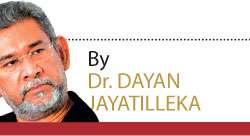Reply To:
Name - Reply Comment
Last Updated : 2024-04-20 18:34:00

 The no-confidence motion must be judged more by its consequences than its intentions. In an interesting speech on April 4, former Speaker Chamal Rajapaksa made the studied observation that the Parliament had witnessed 46 such motions over the decades, of which only ONE was carried — the motion moved by the UNP Government against opposition leader Mr. Amirthalingam. Every one of the 45 other no-confidence motions failed.
The no-confidence motion must be judged more by its consequences than its intentions. In an interesting speech on April 4, former Speaker Chamal Rajapaksa made the studied observation that the Parliament had witnessed 46 such motions over the decades, of which only ONE was carried — the motion moved by the UNP Government against opposition leader Mr. Amirthalingam. Every one of the 45 other no-confidence motions failed.
This fact was known to the former Speaker’s younger brother, a two-term President with half a century of experience in politics, Mahinda Rajapaksa. He knew the motion was unlikely to be carried but went ahead with it anyway. He was of the political generation that was in Parliament when the LSSP and the UNP moved a motion of no-confidence against Prime Minister Sirimavo Bandaranaike in 1975, lost by a huge margin, but fatally damaged the government. Mahinda was heavily influenced by the stratagem of opposition leader JR Jayewardene: crack the coalition government from within, as a prelude to overrunning it from without, at a general election.
That is what Mahinda Rajapaksa did with the ‘no-faith’ move. If one regards the political arrangement as a cluster of billiard balls on the green baize, Mahinda broke open the entire pattern with this move, scattering the government’s forces in a manner that can never be quite regrouped. More: the government is now like a pinball machine.
The pro-Ranil element of the SLFP has slit its electoral wrists by collusion through abstention. It will not divert SLFP votes anymore
On April 4, the Parliament which could have voted in a manner rather more congruent with the public mood and balance of political forces in the country as evidenced on February 10, decided to go the other way, dramatically widening the discrepancy between itself and mass sentiment. In the most glaring grotesquerie, the official opposition leadership was the main prop of the Prime Minister. Inevitably, the PM’s arithmetical victory in Parliament triggered a series of political aftershocks the morning after -- all of them in the government and none in the JO which spearheaded the attack and lost the vote.
After his spectacular success at the local government elections on February 10, at which his populist political movement scored a higher percentage on its first electoral outing, than the iconic SWRD Bandaranaike did in the Silent Revolution of 1956, Mahinda Rajapaksa had a task at hand. That was to bridge the gap between the 40% or 45% (depending on how you calculate it) of the vote he commands and the 10% his forces need in order to jump the magic 50% mark. There was an obvious place to look and that was in the 13% obtained by the official SLFP. He was sure that at the next election he would get most of it, but the motion of no-confidence which was an outcrop of the intra-government contradiction between the UNP and the SLFP, gave him an early opportunity.
 While he was sincere in the support he extended to the SLFP wing of the government and the UNP dissidents, going to the extent of sponsoring the motion when the SLFP made the request and passed the baton, he never fully trusted or relied on his allies. As he told me early in the game, he expected that “Ranil will neutralise the UNP rebels by redistributing some posts.” He was also acutely aware that “President Sirisena may change his mind at the last moment when pressures mount.” A realist, he went ahead, his eye on the prize of drilling through the governing coalition and precipitating an anti-UNP (not anti-Sirisena) rebellion within the SLFP, just as T.B. Subasinghe, Nanda Ellawela, A.M. Jinadasa and Tennyson Edirisooriya rebelled in the last stage of Mrs. Bandaranaike’s government.
While he was sincere in the support he extended to the SLFP wing of the government and the UNP dissidents, going to the extent of sponsoring the motion when the SLFP made the request and passed the baton, he never fully trusted or relied on his allies. As he told me early in the game, he expected that “Ranil will neutralise the UNP rebels by redistributing some posts.” He was also acutely aware that “President Sirisena may change his mind at the last moment when pressures mount.” A realist, he went ahead, his eye on the prize of drilling through the governing coalition and precipitating an anti-UNP (not anti-Sirisena) rebellion within the SLFP, just as T.B. Subasinghe, Nanda Ellawela, A.M. Jinadasa and Tennyson Edirisooriya rebelled in the last stage of Mrs. Bandaranaike’s government.
Ex-President Rajapaksa had to adjudicate a debate within his own ranks. SLPP strategists argued that Ranil was the ‘ideal opponent’ to have; the easiest to defeat. They pointed out that Mahinda had been defeated only when Maithripala Sirisena, who had a profile acceptable to Sinhala-Buddhists, defected and was conferred the candidacy. “Why should we support the no-confidence motion and help the UNP Government to refresh itself?” was the question posed, with the term “refresh” being the exact word used. “Instead of moving no-confidence motions against Ranil, why not simply let him remain in play—he is wrecking the economy, and after all, we have only 17 months more to go!” was their argument.
Pitted against this was the collective view of the leadership of the joint opposition (JO), comprising the February 18, 2015 Nugegoda movement (‘Mahinda Sulanga’/‘Bring Back Mahinda’), which was best expressed as: “If Ranil remains there won’t be a country for us to take over in 17 months — he’ll sell off everything in sight!”
It is these competing perspectives that were misperceived by outsiders such as the JVP and misrepresented at the April 4 debate as the views of the “BR faction” and the “JO’s GR faction” respectively. Weighing these contending perspectives and seeing the merits of both, Mahinda Rajapaksa kept the goalposts within sight: the internal contradictions within the coalition government. Mahinda’s gamble was that the SLFP was not a complete write-off; there was political life and an anti-UNP, anti-Ranil reflex within it yet. It worked. He counted on there being SLFP MPs with guts and a lucid sense of electoral self–preservation. He was not trying to induce them to cross-over, but to emerge as potential anti-UNP allies in a broad front; a resistance movement within the SLFP and the coalition government to complement the massive anti-UNP populist formation he led outside. The no-confidence motion was but a stage or phase in that strategic project.
Mahinda has breached the SLFP ‘blue buffer’ which protects Ranil’s UNP, the JO-SLPP’s main opponent at the national elections of 2019-2020. In the same move, he has caused or catalyzed the emergence of a guerrilla column of SLFP rebels against the UNP, attacking the UNP’s flanks.
The UNP stuck by Ranil and is now stuck with Ranil. Today, after the no-confidence motion, Ranil, the JO-SLPP’s ‘perfect target,’ will be the opponent in 2019. He faces a new contradiction from within the government, is devoid of a two-thirds majority in Parliament, and is exposed before the voting public as having been propped up by the TNA in exchange for a new Constitution and military withdrawal.
The pro-Ranil element of the SLFP has slit its electoral wrists by collusion through abstention. It will not divert SLFP votes anymore. The SLFP’s 13% has shifted either directly to Mahinda or to the SLFP rebel faction which may ally with him. If the UNP takes the Mangala roadmap and moves on a new Constitution and ‘Transitional Justice’ in the coming months, it will be massively defeated at a referendum and overthrown the morning after by the masses, the monks and the military. Even if doesn’t, the UNP will be gone in just “two more Vesak Poyas” as Mahinda mischievously puts it.
Experienced academics and serious analysts in South Asia can clearly see what liberal Sri Lankan civil society intellectuals and academics cannot. Writing ‘Geopolitical Notes from India’ in the Pakistan Observer (April 6, 2018) after the no-confidence vote on Prime Minister Ranil Wickremesinghe, Prof. M.D. Nalapat, UNESCO Peace Chair & Director of Geopolitics, Manipal University, Haryana State, India, Vice-Chair Manipal Advanced Research Group, and former Coordinating Editor of the Times of India, projects the outcome of the Sri Lankan political process in 2019-2020:
“…More than any other reason, it is the perception by Sri Lankans of Sirisena and Ranil bowing to US-EU pressure that is clearing a way for the return to power of former President Mahinda Rajapaksa in the next Sri Lankan election.”
All that Mahinda Rajapaksa has to do is pick a winning Presidential candidate. He has four front-runners to choose from. The two senior-most are Teflon who cannot be framed and jailed. Any of the four can beat Ranil.

Add comment
Comments will be edited (grammar, spelling and slang) and authorized at the discretion of Daily Mirror online. The website also has the right not to publish selected comments.
Reply To:
Name - Reply Comment
On March 26, a couple arriving from Thailand was arrested with 88 live animal
According to villagers from Naula-Moragolla out of 105 families 80 can afford
Is the situation in Sri Lanka so grim that locals harbour hope that they coul
A recent post on social media revealed that three purple-faced langurs near t